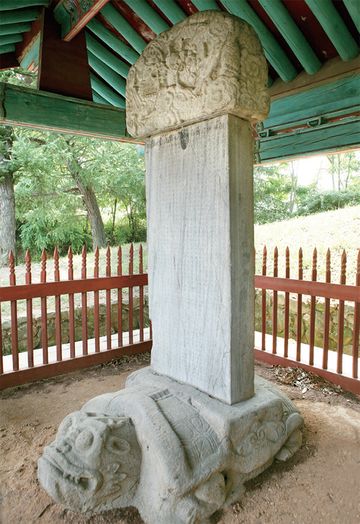"대동법 시행기념비"의 두 판 사이의 차이
(→국문 수정안) |
|||
| 39번째 줄: | 39번째 줄: | ||
===영문=== | ===영문=== | ||
| + | '''Monument for the Enactment of New Tax Law''' | ||
| + | |||
| + | This monument was erected in 1659 to honor Kim Yuk (1580-1658), a civil official of the Joseon period, and his contribution in the enactment of a new tax law. | ||
| + | |||
| + | In the early period of the Joseon dynasty (1392-1910), an in-kind tribute tax was levied on special local products, and it caused onerous burden to the peasant-farmers. To take the place of this tribute tax, a concept of a rice payment was proposed, and a new tax law called ''Daedongbeop'' (meaning “Uniform Land Tax Law”) was first put into effect in Gyeonggi-do Province in 1608. The enactment of this new law was extended throughout the whole country for following 100 years. | ||
| + | |||
| + | In Chungcheong-do Province, the new law was implemented in 1651, thanks to the efforts of the provincial governor Kim Yuk. To commemorate his achievement, the residents of the Chungcheong-do area erected this monument at a major transportation point between Gyeonggi-do and Chungcheong-do. | ||
| + | |||
===영문 해설 내용=== | ===영문 해설 내용=== | ||
2019년 7월 13일 (토) 06:57 판
| 대동법 시행기념비 |
|
 "경기도지정 유형문화재", 평택시史, 평택시. |
|
| 대표명칭 | 대동법 시행기념비 |
|---|---|
| 한자 | 大同法 施行記念碑 |
| 주소 | 경기도 평택시 소사동 140-1 |
| 지정번호 | 시도유형문화재 제40호 |
| 지정일 | 1973년 7월 10일 |
| 분류 | 기록유산/서각류/금석각류/비 |
| 시대 | 조선시대 |
| 수량/면적 | 1기 |
| 웹사이트 | "대동법 시행기념비", 국가문화유산포털, 문화재청. |
|
|
|
해설문
국문
대동법은 조선시대에 공물(貢物:특산물)을 쌀로 통일하여 바치게 한 세금제도이다. 대동법 이전에는 각 지방에서 생산되는 공물을 바치게 하였는데, 생산에 차질이 생기거나 자연재해로 인해 피해를 입은 경우에도 반드시 공물을 특산물로 바쳐야만 했다. 공물의 이런 폐단을 이용한 관리나 상인이 백성을 대신하여 공물로 나라에 바치고 그 대가를 몇배씩 가중하여 백성에게 받아내는 방납(防納)으로 인하여 백성의 부담이 한층 가중되었다.
대동법은 1608년(광해군 즉위년) 경기도에서 처음 실시된 이후 100여년 동안 걸쳐 확대 실시되었다. 이후 김육은 1658년에 사망하고 그 이후 1659년 호서지방 주민이 설치 한 비이다
이 기념비는 영의정(領議政) 김육(金堉)이 충청도에 대동법을 시행하도록 상소하여 실시함으로써 충청도 백성들이 한양서 충청도로 가는 첫관문인 길목에 세원 둔 것으로, 현 위치에서 남동쪽 약50m지점에 세웠던 것을 1970년 현 위치로 이전하여 보존관리하고 있다.
국문 수정안
이 비는 대동법 시행에 대한 김육(金堉, 1580~1658)의 공을 기리기 위해 만들어진 것이다.
대동법은 공납*을 특산물 대신에 쌀로 납부하는 제도로, 선조 41년(1608) 경기도에서 처음 실시된 이후 100여년 동안 걸쳐 확대 실시되었다. 충청도에는 효종2년(1651) 충청감사로 있던 김육의 노력으로 대동법이 실시되었다. 이 비는 효종10년(1659) 호서지방 주민이 건립한 것으로, 충청도로 넘어가는 길목에 세워졌다.
비는 귀부, 비신, 이수를 모두 갖추고 있다. 비문은 이민구가 짓고, 오준이 글씨를 썼다. 원래는 이곳에서 50m 떨어진 곳에 있었으나 1970년대에 옮겨 놓았다.
- 공납: 조선시대 조세 제도 중 하나. 각 지방의 특산물을 중앙 정부에 바치는 제도.
영문
Monument for the Enactment of New Tax Law
This monument was erected in 1659 to honor Kim Yuk (1580-1658), a civil official of the Joseon period, and his contribution in the enactment of a new tax law.
In the early period of the Joseon dynasty (1392-1910), an in-kind tribute tax was levied on special local products, and it caused onerous burden to the peasant-farmers. To take the place of this tribute tax, a concept of a rice payment was proposed, and a new tax law called Daedongbeop (meaning “Uniform Land Tax Law”) was first put into effect in Gyeonggi-do Province in 1608. The enactment of this new law was extended throughout the whole country for following 100 years.
In Chungcheong-do Province, the new law was implemented in 1651, thanks to the efforts of the provincial governor Kim Yuk. To commemorate his achievement, the residents of the Chungcheong-do area erected this monument at a major transportation point between Gyeonggi-do and Chungcheong-do.
영문 해설 내용
참고
- 대동법 시행 기념비 왜 여기에 있나요 ?, 평택시민신문.
- 대동법시행기념비, 한국민족문화대백과사전.
- 대동법시행기념비, 경기문화재연구원.
- 타는 목마름으로 ‘대동법’을 외치다, 시사인.